Project Title: Explore the Cosmos by Shu, Instructor: Gohai.
Based on our initial brainstorm of the project. After narrowing down our ideas, we concluded that we would use the space game idea for our final project. Based on our initial plans for the interactive game, we designed a space-themed scenario, the astronauts are equipped with specialized suits for cleaning up floating trash in certain parts of space. The process involves multiple tasks and coordination among team members. One astronaut, designated as Task Person 1, is responsible for cleaning and determining the direction of the cleaning effort. Meanwhile, Task Person 2 manages the energy blow system and controls the temperature within the spacesuit. The spacesuit is equipped with a humidity sensor that serves a dual purpose – when one astronaut blows into it, the sensor not only regulates humidity but also indicates the volume of oxygen available. The rate at which the person cleaning up the trash blows into the sensor is determined by the level of oxygen, ensuring optimal oxygen supply. The vacuum system is deployed to collect and dispose of the space debris, guided by a laser sensor that controls its movement. Success in Stage 1 is achieved by successfully navigating through the debris-filled space and effectively cleaning up trash. The goal of the game is to triumph in all three stages, avoiding crashes with satellites, meteors, and aliens. Satellites may obstruct the path, but strategic timing allows astronauts to navigate through them. Meteors pose a random threat, and aliens complicate the mission by getting in the way, necessitating the search for alternative routes. Once all the trash is cleared, the focus shifts to a final challenge – combating the aliens. Victory hinges on completing all stages successfully, while failure results from collisions with satellites, meteors, or being impeded by aliens.
After refining our ideas, we are moving forward with the development of “Exploring the Cosmos,” an interactive space travel game designed to engage players in an exhilarating journey through the cosmos while subtly addressing environmental sustainability. In this game, players must actively participate by blowing into a sound sensor, a crucial element for survival in space. The sound sensor is integral to the gameplay as it allows players to maintain an adequate supply of oxygen, a key factor in their survival. The game incorporates a unique design, combining the tasks of cleaning up space trash and providing air into a single box with two functions. The gameplay unfolds in two significant stages, each presenting escalating challenges for players to overcome. In the first stage, players are tasked with cleaning up space trash, encountering obstacles such as satellites that impede their progress. The goal is to successfully collect and recycle ten pieces of space debris. Moving on to the second stage, players face the dual challenge of navigating through space while fending off attacks from aggressive balls. To survive, players must control the sound sensor to monitor and adjust oxygen levels, ensuring their sustained survival. Additionally, players need to manage temperature levels to counter any insufficiencies. To emerge as the ultimate winner, players must successfully navigate both stages. Throughout the game, players contribute to a cleaner space environment by actively collecting and recycling space rubbish, earning scores in the process. By incorporating elements of environmental management and strategic decision-making, the project aims to educate players on the consequences of their choices within an engaging gaming experience. This game not only promotes awareness of environmental issues related to space trash but also encourages critical thinking among players. Drawing a connection to the principles discussed in “The Art of Interactive Design,” which underscores the importance of interaction involving listening, thinking, and speaking, our game prioritizes high levels of engagement and interaction. The design ensures that players actively participate with their partner and the game itself, embodying various degrees of interactivity involving listening, thinking, and speaking.
After the user testing, we made some improvements to our game. We take into consideration inserting sounds such as space sounds, trash disposal sounds, winning sounds, and losing sounds into our game. On top of that to make our screen bigger. Another tip to improve the clarity and the rules of the game is to label our buttons and make it more obvious to the players when they are playing our game. Lastly, one final tip is to add acceleration to our movement. When the astronaut is moving and when moving, it will accelerate to the right and determine the direction of the movement. The key to this top is to have movement exist after the button is pressed.
The initial plan is very different from the final game because at first we decided to have rounds of astronauts collecting trash and we thought this way the game is not going to be as interactive and entertaining to play with. Therefore, instead of rounds of players collecting different amounts of trash, we have the player collect 10 pieces of trash and a second round of different types of game of blowing in oxygen to supply yourself with oxygen and not get hit by the ball.
During the fabrication stage, we used laser cutting for the design of the box and some of the decorations on the box. First, we use cuttle to design the box and they are in the size of 40cm x 15cm for the long rectangle sides, and for the square sizes, it is in the size of 15cm x 15cm. Then, for the color of the printouts, we decided to put the box black because it is used to match the aesthetic of the space theme. In addition, the rockets and the stars are also used through laser printing and painted over in colors. Another component that was included is the 3-D printing of the astronaut that is used to showcase the main character of our game which is surviving in space. This part of the process was designing and printing it out to see the results of our product. One issue that we ran into for the first astronaut that we 3-D printed it was too small, but after adjusting the size. It got better. For the coding part and the overall part production of the project, we divided up the work evenly and made sure that my partner and I were on track for our progress in the project. In addition, some challenges we faced along the way with the code are getting the acceleration movements of the button and bugs of our wires not connecting with the process. For the acceleration, we seek out help through Gohai, and for the connections of the buttons. We had to reconnect the wires and make sure it would connect back and work again in the game.
In conclusion, one thing that we can do if we have more time is definitely working on merging the first and second stages of the game with more transitions, and for the games, we can have more levels that can be incorporated. This is probably because, in the first stage of the game, more people found it fun just collecting the trash. However, suddenly in stage two, the game is a bit different from game 1. With more time, I want to make the integration between stages 1 and 2 better. Another thing is to have straws in a bucket and have a grab-and-go-use option for the users or players to let them know that it will be safe to use.
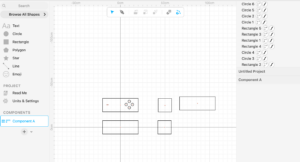
Image for the laser-cut of the box 🖍️
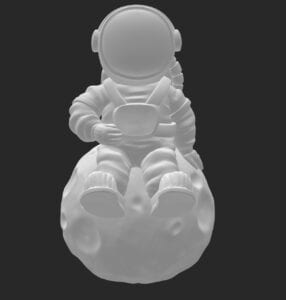
Image for the astronaut 3-D model 🌕
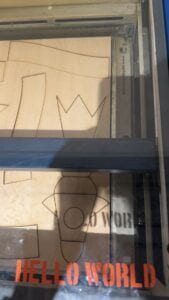
Image laser-print for the rocket 🚀 and stars ⭐️ decorations
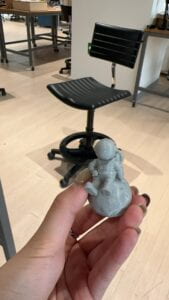
Image for the small-tested print of the astronaut 🧑🏻🚀
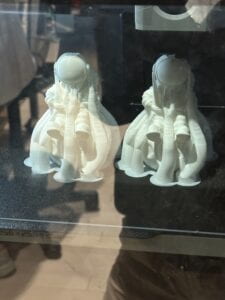
Image for the 3-D print of the astronaut 🧑🏻🚀
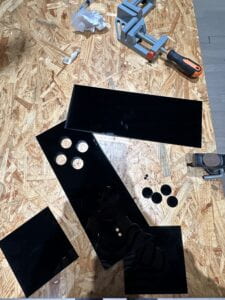
Image for the laser-cutting for the black box 📦
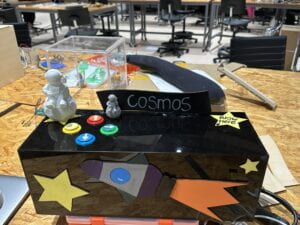
Images for the final product for the box ✅
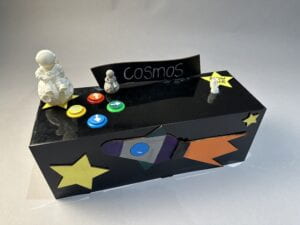
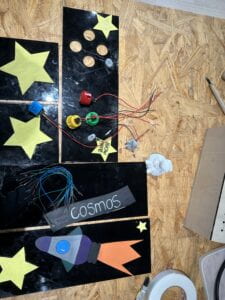
Image of taking apart our project 🥲.
Attached below the link for materials that was a part of the project ex: sounds, the code from arduino and processing, videos of the project, another materials.
https://drive.google.com/drive/folders/1YxeC-KGHqT9NwLESIqXc
mWFCv2yviUhF?usp=drive_link
Citation for the sounds that is incorporated: https://pixabay.com/sound-effects/search/game%20finish/
Sounds used from the website
Pixabay. “Force-Field.” MP3 file. https://pixabay.com/sound-effects/search/game%20finish/
Pixabay. “Game-Start.” MP3 file. https://pixabay.com/sound-effects/search/game%20finish/
Pixabay. “Garbage Disposal.” MP3 file. https://pixabay.com/sound-effects/search/game%20finish/
Pixabay. “Negative_beeps.” MP3 file. https://pixabay.com/sound-effects/search/game%20finish/
Pixabay. “Sci-Fi-ambient-Drone.” MP3 file. https://pixabay.com/sound-effects/search/game%20finish/
Pixabay. “Sucess-1.” MP3 file. https://pixabay.com/sound-effects/search/game%20finish/
Pixabay. “WinsSquare.” MP3 file. https://pixabay.com/sound-effects/search/game%20finish/